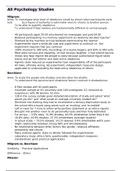All Psychology Studies
Milgram:
Aims: To investigate what level of obedience would be shown when participants were
told lotus. by a figure of authority to administer electric shocks to another person.
Lake. To be able to quantify obedience.
Lake. To understand if Nazi soldiers are fundamentally different to normal people.
- 40 participants aged 20-50 volunteered via newspaper and paid $4.50
- Believed participating in a memory experiment as randomly decided ‘teacher’
- Shocked by the machine so truly believed electrocuting the ‘learner’
- Experimenter wore a white lab coat and urged them to continue i.e. ‘the
experiment requires that you continue’
- 100% shocked to 300 volts (recordings of screams began), and 65% to 450 volts
- Most were nervous and sweating, 14 had nervous laughter, 1 had violent seizure
- Shows why Nazi regime led people to obey because authoritative figure takes
blame and we feel inferior and destructive obedience
- Agentic state induced as experimenter took responsibility off of the participant
- All male, ethically wrong, lab experiment, independent measures design,
applicable to understanding the destructive obedience of others
Bocchiaro:
Aims: To study the people who disobey and who blow the whistle.
Lake. To understand the personal and situational factors involved in disobedience.
- 8 Pilot studies with 92 participants
- Volunteer sample at VU university with 149 undergrads (11 removed as
suspicious), with 96 women, 53 men
- 138 in the survey sample given detailed description of study and asked ‘what
would you do?’ and ‘what would an average university student do?’
- Deceived into thinking they had to recommend a sensory deprivation study to
the school ethics board using words such as ‘exciting’ and ‘incredible’
- Left in room for 7 mins to either write positive statement or an ethics reports
- Brought into another room to do personality tests and then fully debriefed
- For survey ~ 3.6% obey, 31.9% disobey, 64.5% whistleblow (what they’d do)
- 18.8% obey, 43.9% disobey, 37.3% whistleblow (average student)
- In actual study ~ 76.5% obeyed, 14.1% obeyed, 9.4% whistleblew w/6% anon
- Slight relationship between strong faith and whistleblowing
- No relationship between other factors like gender, religious affiliation,
personality test results
- Many entered agentic state so blindly followed the experimenter
- Laboratory study, ethics fairly questionable, independent measures,
standardised, good practical applications
Milgram vs. Bocchiaro
Similarity: - Practical Applications
Difference: - Ethics
Piliavin:
, Aims: To conduct a field experiment to investigate the effect of several different
variables she on who responded to help
- 4550 participants (55% white 45% black) in 103 trials on a New York Subway for
7.5 continuous mins
- 4 groups of 4 experimenters – 2 males acting, 2 women recording, in 1 group, 1
black man
- 1 male acted as the ‘victim’ who was either drunk w/ alcohol in brown bag and
smelled of alcohol, or ill w/ a cane
- After 70 secs, he collapsed in the centre of the carriage, waiting for help
- Other man either offered no help, stood in critical area and helped after 70 secs,
or 150 secs, or from adjacent area after 70 secs, or 150 secs
- In all but 3 of the cane trials, victim received help before the model intervened
- Men more likely to help than women
- Spontaneous help before 70 secs was more common in cane than drunk
- No difference in help towards black or white victims
- Drunk black victim more likely to receive help from own ethnicity
- Victims received help in 81/103 trials, and in 60%, help was from more than one
person
- The longer the victim went w/out help, the more likely people were to move
away or verbally justify not intervening
- No consent from any of the participants, during same time (11am – 3pm) so Ps
could have done task before, no debrief, more cane trials than drunk trials,
more white victims than black victims, didn’t know participating so wouldn’t
change their normal behaviour, ethnocentric
Levine:
Aims: To determine if a city’s tendency to offer non-emergency help to strangers is
stable frogs across situations over a wide range of cultures.
She. To research whether substantial variation exists across the cultures studied.
She. To identify country-level variables that might relate to differences in helping.
- 23 cities measured based on population, their PPP, a rating from 0-10 on
whether they were individualist or collectivist, and their pace of life
- Pace of life was measured by average time it took for 35 men and women to
walk 60ft between two pointa
- Task 1) 214 men, 210 women passed in street and the experimenter dropped a
pen when 15ft away
- Task 2) 253 men, 240 women passed in street, experimenter wore a leg brace
and dropped magazines
- Task 3) 281 trials w/ experimenter trained to act blind and went to crossing just
before light went green, waiting for assistance for 60 secs/if light turned red
- Experimenters were male, college age, dressed neatly, didn’t communicate w/
Ps, and trained to ensure similar experience for all Ps
- Most helpful were Rio de Janeiro (93.9%) and San Jose, least helpful were Kuala
Lumpar (40.33%) and New York City
- Quicker pace of life, individualist countries, non-simpatia = less likely to help
- New York anomaly as Blind had 75% help, but for leg brace only 28%
- No consent from Ps, highly controlled via training and similar Es, not
ethnocentric, good practical applications
Piliavin vs. Levine





